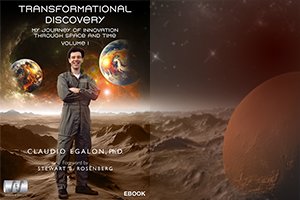BIOGRAPHY CLAUDIO OLIVEIRA EGALON
Dr. Claudio Oliveira Egalon has a Bachelor degree in Physics from the Federal University of Rio de Janeiro in Brazil, a Master and a Ph.D. degrees in Physics from the College of William and Mary and a second Ph.D. in Electrical Engineering from Old Dominion University. Between 1987 and 1996 he worked for NASA Langley Research Center in Hampton, VA. In 1992 and 1993 he became the first Brazilian citizen to conduct microgravity experiments on board NASA’s KC-135: the same airplane used to train astronauts. In these experiments, he helped process glass fibers, made of an infrared transmitting glass, ZBLAN, and helped determine that they became more transparent when processed in microgravity. In 1997 and 1999 he applied for NASA’s Astronaut Selection Program and ranked among the top 400 candidates from a total of 3,000 applicants.
During his years at NASA he also pioneered a new type of sensor that uses side illumination of an optical fiber. This type of technique represents a complete departure from the regular way optical fibers are illuminated: axial illumination. The resulting sensors demonstrated to be very simple, to have a very high density of sensing points along the fiber, to be cost effective compared with regular optical fiber sensors and to be very sensitive, among other characteristics. Since then, he discovered several configurations of this type of device and patented them: he now owns a total of 29 patents on this technique, both in the US and overseas, and has several more patents pending. These sensors have proven to be useful in many different applications and, due to its high density of sensing points, can be considered the precursor of the first artificial nerve. Since 2007, his sensor configurations have been reproduced, and copied, by researchers in Canada, Brazil, Spain, Italy, Hong Kong and China.
Dr. Egalon’s research has been funded by NASA, the US Air Force, the National Science Foundation (NSF), the National Institutes of Health (NIH), the US Department of Agriculture (USDA) and the Brazilian funding agencies FAPESP and FACEPE from the states of São Paulo and Pernambuco, respectively. He also held consulting jobs with W.R. Grace, Spectrum Technologies, Baker and Hughes and the Physical Optics Corporation. Throughout his career he taught Physics and Astronomy at several California Community Colleges and US universities such as University of Puerto Rico, Loyola Marymount University and the California State University at Dominguez Hills. He co-authored a book in Brazil about the space program, the first of its kind to be entirely produced in Brazil, authored two lab manuals in Physics, one lab manual about his own technology, a Physics notes in Mechanics and several technical papers.

